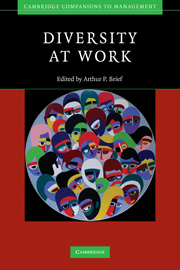Book contents
- Frontmatter
- Contents
- List of figures
- List of tables
- List of contributors
- Foreword
- Preface
- 1 Introduction: Where the sweet spot is: Studying diversity in organizations
- Part I Conceptual foundations
- Part II Emerging theoretical approaches
- 4 Identity negotiation processes amidst diversity
- 5 Diversity, conflict, and their consequences
- 6 Shifting frames in team-diversity research: From difference to relationships
- 7 Putting your own down: How members of disadvantaged groups unwittingly perpetuate or exacerbate their disadvantage
- Part III Moving ahead: Agendas for practice and research
- Index
- References
5 - Diversity, conflict, and their consequences
Published online by Cambridge University Press: 19 May 2010
- Frontmatter
- Contents
- List of figures
- List of tables
- List of contributors
- Foreword
- Preface
- 1 Introduction: Where the sweet spot is: Studying diversity in organizations
- Part I Conceptual foundations
- Part II Emerging theoretical approaches
- 4 Identity negotiation processes amidst diversity
- 5 Diversity, conflict, and their consequences
- 6 Shifting frames in team-diversity research: From difference to relationships
- 7 Putting your own down: How members of disadvantaged groups unwittingly perpetuate or exacerbate their disadvantage
- Part III Moving ahead: Agendas for practice and research
- Index
- References
Summary
Introduction
In recent years, diversity has come to play a central role in organizational life, due to increased globalization, greater workforce diversity, and the increasing complexity of jobs (Williams and O'Reilly, 1998). Scholars have investigated the impact of diversity on organizational outcomes such as performance or satisfaction, but findings on these effects have been largely inconsistent (for reviews and meta-analyses see Jackson, Joshi, and Erhardt, 2003; Mannix and Neale, 2005; Stewart, 2006; Webber and Donahue, 2001; Williams and O'Reilly, 1998). To better understand how diversity impacts organizational groups, research began to examine the processes underlying the effects of diversity on performance (e.g., Jehn, Northcraft, and Neale, 1999; Pelled, Eisenhardt, and Xin, 1999). Conflict has arisen as a primary process in explaining the effects of diversity upon performance (cf. Williams and O'Reilly, 1998; Lau and Murnighan, 1998). This chapter reviews the literature relating diversity, conflict, and performance and then discusses the new directions the field is heading in.
We will begin by briefly reviewing the theory and findings on diversity's effect on group processes and performance. We will identify the trends found in these studies as well as identify areas of diversity research that have not received as much attention in recent reviews and meta-analyses. We will then expand on recent developments in the diversity field. Then, we will move to the conflict literature. We will describe the intra-group conflict literature as it now stands and then specify the new directions within that field.
- Type
- Chapter
- Information
- Diversity at Work , pp. 127 - 174Publisher: Cambridge University PressPrint publication year: 2008
References
- 16
- Cited by



